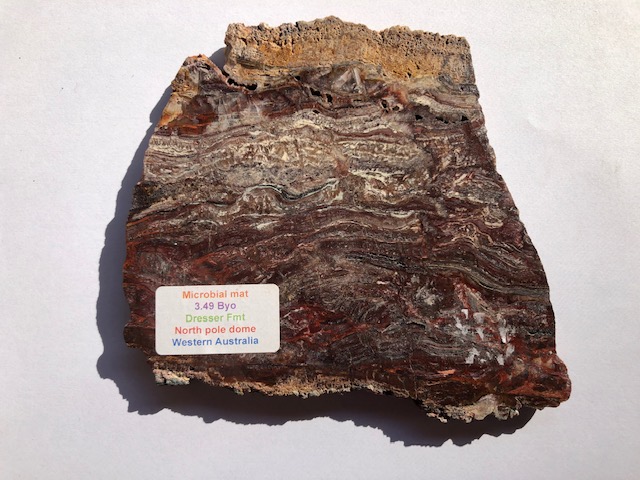Cite as: Benner, S. A. (2021) “Minerals, Mars, and 3.48 Billion Year Old Australian Fossils”. Primordial Scoop, 2021, e0124. https://doi.org/10.52400/RQAD6832
Martin van Kranendonk and his co-authors published a paper last week in the journal Astrobiology that makes an important connection between geology and early life on Earth [1]. The paper discusses the Dresser Formation from Northwest Australia, a formation that holds some of Earth’s oldest fossils: microbes that were living around hot springs 3.48 billion-years ago.
This paper builds upon findings from 2017, when same team found evidence that those hot springs were not at the bottom of an ocean but, at least in part, on land. This evidence came in the form of silica-containing deposits (for example, geyserite) formed only when the hot water flows into air. Analogous hot springs are known today, for example, in New Zealand, and the latest paper shows pictures of these.
These observations make the connection between life and land at this time. Further, these are environments that likely occurred on Mars, where they could have given rise to Martian life.
New in the paper this week are data that suggested that at least at such spots on Earth, life could have originated. At least it had the Periodic Table elements that it needed. Van Kranendonk et al. found the elements usually considered to be important: carbon, phosphorus, sulfur, and nitrogen, for example. However, they also found a few others, including zinc (an element liked by Armen Mulkidjanian) and … boron.
Boron, as many of you know, manages the “tar paradox” in the prebiotic chemistry of carbohydrates. Borate grabs on to adjacent hydroxyl groups of simple sugars, and allows them to undergo controlled maturation to give, inter alia, ribose, the “R” in “RNA”.
The appearance of borate in these deposits in “useful” amounts at this antiquity helps us understand the evolution of minerals on Earth. Bob Hazen, Dimitri Sverjensky, and others had, a decade ago, argued that boron would not be available in useful amounts on early Earth, before plate tectonics had had the opportunity to churn and fractionate it into useful deposits. And yet here it is, in tourmalines that survived from a time that represents three-fourths of the way back to the birth of the Earth.
And borate has been found on the surface of Mars.
In a few days, Perseverance will be landing on Mars in Jezero Crater. This locale could easily have had hot springs like those in in the Dresser formation. And life?
Elsewhere on this site, Jan Špaček has remarked on a strategy to search for universal genetic biosignatures of extant life on Mars at the same time that SpaceX is mining water for in situ fuel generation. If life emerged on Mars, and then survived there, Špaček’s strategy will find it.
Of course, Martian life may have emerged in borate-containing hot springs and then gone extinct. However, everything that we have learned from our studies of the terran biosphere is that “life … uh … finds a way” to survive. Perhaps even Martian life.
So the von Kranendonk et al. paper reminds us of the urgency of following Špaček’s advice to look for Martian life as soon as possible.
Van Kranendonk, M. J., Baumgartner, R., Djokic, T., Ota, T., Steller, L., Garbe, U., & Nakamura, E. (2021). Elements for the origin of life on land: A deep-time perspective from the Pilbara Craton of Western Australia. Astrobiology, 21(1), 39-59.



